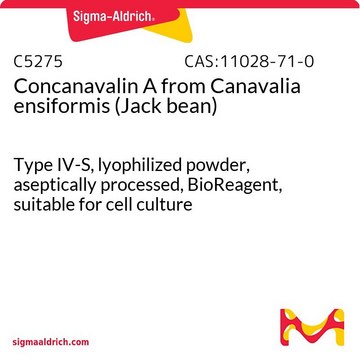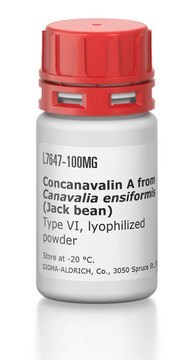C9017
Concanavalin A from Canavalia ensiformis (Jack bean)
Sepharose™ conjugate, buffered aqueous suspension
Sinonimo/i:
ConA
About This Item
Prodotti consigliati
Origine biologica
Canavalia ensiformis
Livello qualitativo
Coniugato
Sepharose™ conjugate
Forma fisica
buffered aqueous suspension
contiene
20% ethanol as preservative
Grado di funzionalizzazione
10-16 mg per mL
Matrice
Sepharose 4B
Attivazione matrice
cyanogen bromide
Gruppi immobilizzati alla matrice
amino
Braccio spaziatore
1 atom
Capacità
≥25 mg/mL binding capacity (thyroglobulin)
Temperatura di conservazione
2-8°C
Cerchi prodotti simili? Visita Guida al confronto tra prodotti
Applicazioni
Azioni biochim/fisiol
Stato fisico
Risultati analitici
Note legali
Prodotti correlati
Avvertenze
Danger
Indicazioni di pericolo
Consigli di prudenza
Classi di pericolo
Repr. 2 - Resp. Sens. 1 - Skin Sens. 1
Codice della classe di stoccaggio
3 - Flammable liquids
Classe di pericolosità dell'acqua (WGK)
WGK 3
Punto d’infiammabilità (°F)
102.2 °F
Punto d’infiammabilità (°C)
39 °C
Certificati d'analisi (COA)
Cerca il Certificati d'analisi (COA) digitando il numero di lotto/batch corrispondente. I numeri di lotto o di batch sono stampati sull'etichetta dei prodotti dopo la parola ‘Lotto’ o ‘Batch’.
Possiedi già questo prodotto?
I documenti relativi ai prodotti acquistati recentemente sono disponibili nell’Archivio dei documenti.
I clienti hanno visto anche
Il team dei nostri ricercatori vanta grande esperienza in tutte le aree della ricerca quali Life Science, scienza dei materiali, sintesi chimica, cromatografia, discipline analitiche, ecc..
Contatta l'Assistenza Tecnica.









